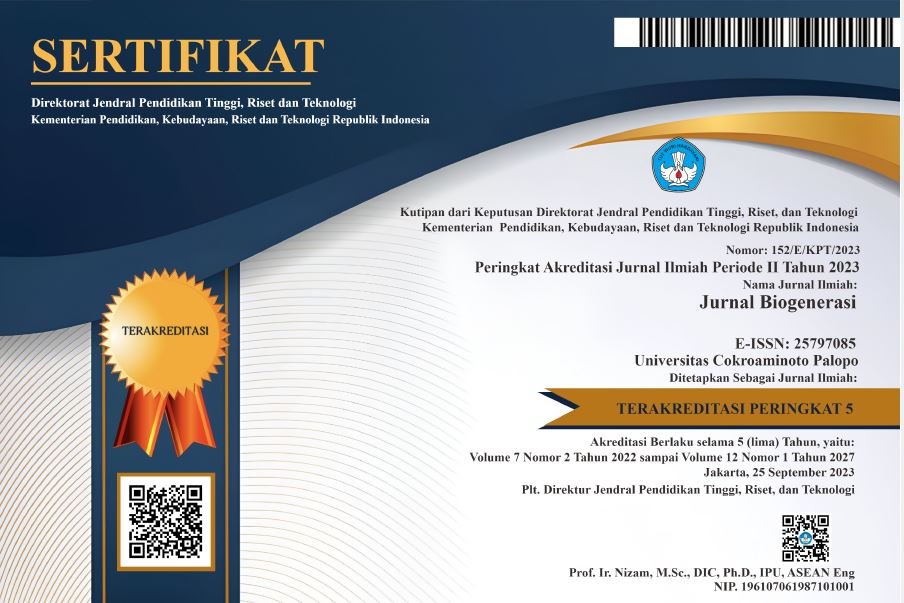ANALISIS HIGHER ORDER THINKING SKILLS (HOTS) KELAS XI : PENGARUH MODEL FLIPPED CLASSROOM
DOI:
https://doi.org/10.30605/biogenerasi.v10i2.5721Keywords:
Flipped Classroom, Higher order thinking skills, BiologyAbstract
Field studies show that students' higher order thinking skills (HOTS) are still low. This research aims to determine the impact of using the flipped classroom model on students' higher order thinking skills (HOTS). In its implementation, this research used a quasi-experimental method. There are two classes used, namely the control class and the experimental class, which were obtained using the cluster random sampling technique. The experimental class uses a flipped classroom model and the control class uses a exspository learning model. The instruments used in this research is test. The test instrument is to measure students' HOTS. Based on the results of the hypothesis test, the sig value is obtained. 0.000 < 0.05 so it can be seen that the flipped classroom model can be used to increase students' HOTS.
Downloads
References
Adhitya, E. N. (2015). Studi Komparasi Model Pembelajaran Traditional Flipped dengan Peer Instruction Flipped Terhadap Kemampuan Pemecahan Masalah. Unnes Journal of Mathematics Education, 4 (2).
Azhary, L., & Ratmanida, R. (2021). The Implementation of 21st century skills (communication, collaboration, creativity and critical thinking) in English lesson plan at MTsN 6 Agam. Journal of English Language Teaching, 10 (4).
Azzahra, W., dan Alberida, H. (2020). Pengaruh Penerapan Model Problem Solving Terhadap Keterampilan Berpikir Tingkat Tinggi dan Aktivitas Belajar Peserta Didik. Bioeducation Journal, 4 (1).
Fedistia, R., & Musdi, E. (2020). Efektivitas Perangkat Pembelajaran Berbasis Flipped Classroom untuk Meningkatkan Kemampuan Penalaran Matematis Peserta Didik. Jurnal Didaktik Matematika , 7(1).
Fikri, S. A. (2019). Flipped Classroom terhadap Kemampuan Pemahaman Konsep Matematis Siswa. Prosiding Sendika, 5 (1).
Fradila, Y., Mulyoto, & Sutimin, L. A. (2015). Model Flipped Classroom dan Discovery Learning Pengaruhnya terhadap Prestasi Belajar Matematika Ditinjau dari Kemandirian Belajar. Teknodika, 13(2).
Hayati, R. (2018). Flipped Classroom dalam Pembelajaran Matematika : Sebuah Kajian Teoritis. Prosiding Seminar Nasional Matematika dan Pendidikan Matematika, “ Integrasi Budaya, Psikologi, dan Teknologi dalam Membangun Pendidikan Karakter Melalui Matematika dan Pembelajarannya .”
Heong, Y. M., Othman, W. B., Yunos, J. B. M., Kiong, T. T., Hassan, R. Bin, & Mohamad, M. M. B. (2011). The level of marzano higher order thinking skills among technical education students. International Journal of Social Science and Humanity, 1(2).
Ismiati, I., Sarwi, S., & Marwoto, P. (2020). Pola dan Kemampuan Pemecahan Masalah Peserta Didik melalui Pembelajaran Flipped Classroom Berbasis Proyek. ORBITA: Jurnal Kajian, Inovasi Dan Aplikasi Pendidikan Fisika, 6 (1).
Jannah, F., Radiansyah, R., Sari, R., Kurniawan, W., Aisyah, S., Wardini, S., & Fahlevi, R. (2022). Pembelajaran HOTS berbasis pendekatan lingkungan di sekolah dasar. Primary: Jurnal Pendidikan Guru Sekolah, 11 (1).
Krisnanto, H., Taufiqulloh, dan Prihatin, Y. (2023). Pengaruh Model Pembelajaran Flipped Classroom terhadap Pelajaran Bahasa Inggris di SMP Negeri 1 Pangkah. Journal of Educational Research , 4 (3).
Maoidah, I. S., Ruhimat, T., & Dewi, L. (2017, Agustus). Efektivitas Penerapan Model Pembelajaran Flipped Classsroom pada Peningkatan Kemampuan Berpikir Kritis Siswa. Edutcehnologia, 3(2).
Mirlanda, E. P., Nindiasari, H., & Syamsuri. (2019). Pengaruh Pembelajaran Flipped Classsroom terhadap Kemandirian Belajar Siswa Ditinjau dari Gaya Kognitif Siswa. Symmetry: Pasundan Journal in Mathematics Learning and Education, 4(1).
Miterianifa, M., Ashadi, A., Saputro, S., & Suciati, S. (2021). Higher order thinking skills in the 21st century: Critical thinking. Proceedings of the 1st International Conference on Social Science, Humanities, Education and Society Development, ICONS 2020, 30 November, Tegal, Indonesia.
Nouri, Jalal. 2016. The Flipped Classroom: for Active, Effective, and Increased Learning Especially for Low Achievers. International Journal of Educational Technology in Higher Education, 13 (33).
Saputra, M. E. A., dan Mujib, M. (2018). Efektivitas Model Flipped Classroom Menggunakan Video Pembelajaran Matematika terhadap Pemahaman Konsep. Desimal : Jurnal Matematika, 1 (2).
Savitri, O. dan Meilana, S. F. (2022). Pengaruh Model Pembelajaran Flipped Classroom terhadap Pemahaman Konsep IPA Siswa Sekolah Dasar. Jurnal BASICEDU, 6 (4).
Sofyan, F. A. (2019). Implementasi HOTS pada kurikulum 2013. INVENTA: Jurnal Pendidikan Guru Sekolah Dasar, 3(1), 1-9.
Subagia, I Made. (2017). Penerapan Model Pembelajaran Flipped Classroom Untuk Meningkatkan Prestasi Belajar IPA Siswa Kelas X AP 5 SMK Negeri 1 Amalapura Tahun Ajaran 2016/2017. Lampuhyang.8 (2).
Supriyatni, M. (2021). Meningkatkan Hasil Belajar IPA Melalui Model Pembelajaran Flipped Classroom Terintegrasi Portal Rumah Belajar untuk Siswa SD. JIRA : Jurnal Inovasi dan Riset Akademik, 2 (8).
Widodo, L. S., Prayitno, H. J., dan Widyasari, C. (2021). Kemandirian Belajar Matematika Siswa Sekolah Dasar melalui Daring dengan Model Pembelajaran Flipped Classroom. Jurnal BASICEDU, 5 (5).
Downloads
Published
How to Cite
Issue
Section
License
In submitting the manuscript to the journal, the authors certify that:
- They are authorized by their co-authors to enter into these arrangements.
- The work described has not been formally published before, except in the form of an abstract or as part of a published lecture, review, thesis, or overlay journal.
- That it is not under consideration for publication elsewhere,
- That its publication has been approved by all the author(s) and by the responsible authorities – tacitly or explicitly – of the institutes where the work has been carried out.
- They secure the right to reproduce any material that has already been published or copyrighted elsewhere.
- They agree to the following license and copyright agreement.
License and Copyright Agreement
Authors who publish with this journal agree to the following terms:
- Authors retain copyright and grant the journal right of first publication with the work simultaneously licensed under Creative Commons Attribution License (CC BY 4.0) that allows others to share the work with an acknowledgment of the work's authorship and initial publication in this journal.
- Authors are able to enter into separate, additional contractual arrangements for the non-exclusive distribution of the journal's published version of the work (e.g., post it to an institutional repository or publish it in a book), with an acknowledgment of its initial publication in this journal.
- Authors are permitted and encouraged to post their work online (e.g., in institutional repositories or on their website) prior to and during the submission process, as it can lead to productive exchanges, as well as earlier and greater citation of published work.


.png)

